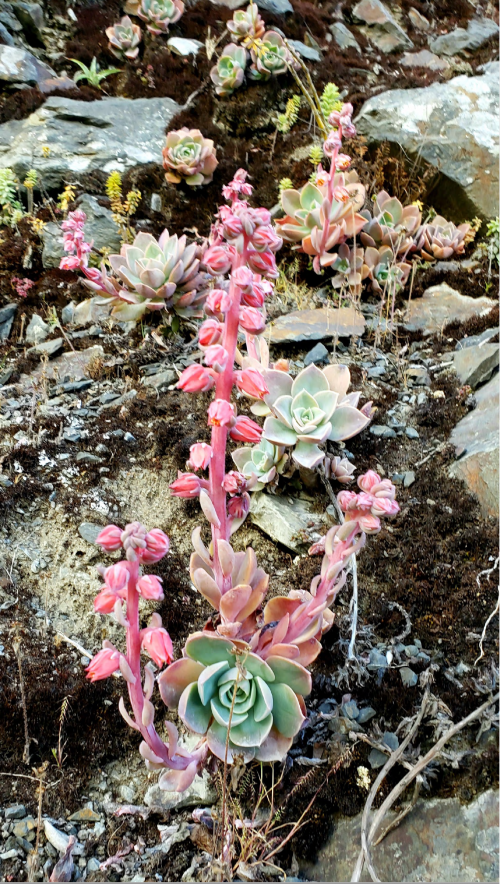INTIWAITA Pino & Payano, 2021
Series Racemosae
Type : Pino & Payano 3297, Peru, dept. Junin, prov. Concepción, distr. Cochas, 3271 m, Apr 14 2021.
Etymology : "Inti" is the Quechua name of the Sun God of the Incas. In the local Junin dialect "waita" means flower. So"Intiwaita" means "Flower of the Sun God".
Distribution : Occurring only in six adjacent localities in prov. Concepción, dept. Junin.
Description :
A succulent glabrous herb.
Stem conspicuous, thick, erect, sometimes branching at base.
Rosettes terminal, simple, 4.5–8.5 cm diam.
Leaves in young plants 8-11, obovate, almost erect, mucronate; in mature plants 14–27, arranged spirally in 45º at the last 1– 1.5 cm of distal stem, sessile, central leaves obovate, peripheral ones very narrowly obovate, 3–5 cm long, 0.7–0.9 cm wide at base, 0.9–1.2 cm wide at proximal third, 1.4–2.3 cm wide at middle, 1.7–2.4 wide at distal third, 0.4–0.5 cm thick, upper side slightly concave to canaliculate, glaucous, dark reddish to purplish near margins or distal third, central leaves completely glaucous; lower side very convex, subcarinate near apex, dark to bright reddish or the whole surface glaucous, margins smooth, apex subobtuse with a 1 x 1 mm recurved mucro, base subcuneate, hyaline, lighter in colour.
Flowering stem 1(–2) erect, a slightly incurved raceme, rachis 12–18 cm long, 3.8–5 mm diam. at base, tapering to 2–3 mm diam. at apex, light green to dark red, glaucous.
Peduncular bracts 10–18, larger at the proximal half, spaced evenly 0.4–1.2 cm all along the stem, crowded at the beginning of anthesis near apex and more or less appressed to the peduncle, sometimes pseudoopposite at the base, oblong to very narrowly obovate, 2.2–3 cm long, 0.8–1.5 cm wide, 3–4 mm thick, upper side flat to convex or subcanaliculate, lower side subcarinate, both sides same color as leaves, reddish green near apex and lighter near base, tips obtuse with a 0.5 mm recurved reddish mucro, base hyaline.
Flowers 8–14, appearing from May to June, present only at distal third or half of the scape, 1–1.2 cm long and 7–11 mm diam., each closely subtended by a small 1–1.5 cm long, 0.35–0.45 cm wide, 2– 3 mm thick lanceolate bract, strongly incurved, adaxially concave, abaxially convex, generally surpassing slightly flower length. Pedicels in right angle or recurved, 1–6 mm long, 1.8–2 mm diam., same color as flowering stem. Calyx lobes united at base, sepals unequal, oblong to narrowly ovate, acute, ascending or spreading in 30º, both sides convex, 7–9 mm long, 2.5–4.5 mm wide, intense red. Corolla subpentagonal, 0.8–0.9 cm diam. at base, 0.5–0.6 cm diam. at apex, 1–1.2 cm long, petals oblong to lanceolate, acute, 1–1.3 cm long, 4.5–6 mm wide, outer surface keeled, dark red, pruinose, proximal half sometimes orangish, apex slightly recurving, redder, inner surface light red, orangish in proximal half. Stamens 10, the 5 epipetalous 6–7 mm long, the antesepalous 8–9 mm long, filaments cream, 0.6–0.8 mm thick at base, gradually tapering to 0.2 mm. Anthers ovate, yellow, 1.5–2 mm long and 0.8–1 mm wide.
First described in CSJ US 93(4) : 290-293. 2021.

Photo Guillermo Pino